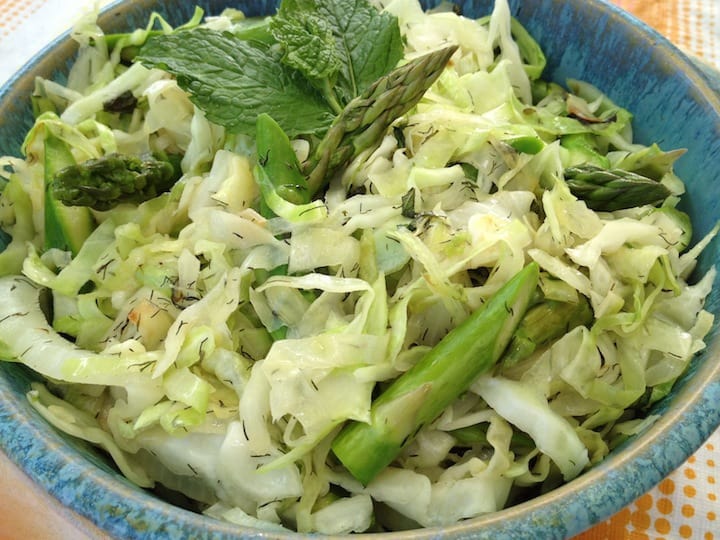Once considered somewhat of a delicacy, modern farming and technology have been able to provide us with asparagus for a good part of the year. However, at its heart, asparagus is still an iconic spring vegetable—one of the first specimens to mark the arrival of the season when its peculiar shoots peek from the ground among wispy, fern-like foliage. Asparagus is my all-time favorite vegetable, so I’m always looking for new ways to add it into my dinner routine when the spears are at their peak between late February and early summer. Succulent and tender, asparagus has been prized since ancient times both for its unique, unparalleled flavor, and health benefits.
This fresh and flavorful side dish makes the most of the seasonal vegetable and provides an exceptional accompaniment to lamb, poultry, or fish. The addition of economical cabbage adds a contrasting and complementary texture and flavor, while also stretching out the asparagus, which can be expensive, even at peak season. Try to keep the cooking to a minimum so the vegetables still retain a lot of their crunch. Shelled baby peas (fresh or frozen) make a great addition, adding little bursts of sweetness.
Ingredients
Serves 4-6
3 tablespoons butter
1 onion, sliced
1 small head green cabbage, cored and thinly sliced
1 pound asparagus spears, trimmed of tough ends, cut into 1½-inch lengths
1 cup fresh of frozen peas (optional)
2 tablespoons fresh dill, chopped (or 2 teaspoons dried dill)
2 tablespoons fresh mint, chopped
Salt and pepper, to taste
Instructions
1. Melt butter in a large, shallow pan over medium heat. Cook onions, without browning, until tender. If using dried herbs, add to onions before adding other vegetables.
2. Add cabbage and asparagus (and peas, if using). Saute until vegetables are crisp-tender. Stir in fresh herbs. Season with salt and pepper to taste.
AUTHOR’S NOTE
To choose your organically grown and fresh ingredients wisely, use the following criteria:
·chemical- and hormone-free meat
·wild-caught fish
·pastured-raised, organic eggs
·whole, unrefined grains
·virgin, unrefined, first-press organic oils
·whole-food, unrefined sweeteners
·pure, clean, spring water
·sea salt
·raw and/or cultured milk and cream products


